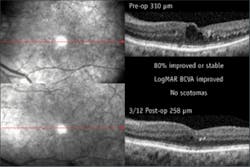Nonthermal laser treatment targets macular degeneration
Clinical results of an ongoing study of laser-based retina-regeneration therapy have demonstrated the potential for this technique to improve and stabilize visual acuity and to reduce retinal edema in patients with diabetic maculopathy and macular edema without damaging the photoreceptors. The therapy utilizes the 2RT system from Ellex Medical (Adelaide, SA, Australia).
At the annual meeting of the American Academy of Ophthalmology last November, Dr. Peter Hamilton, principal clinical investigator in the Ellex 2RT research program at St. Thomas Hospital (London, England), presented a preliminary report on 18 patients (29 eyes) with diabetic macula edema who were treated with the 2RT approach. Short pulses (3 ns) of 532 nm laser energy were used to stimulate the retinal pigment epithelium, creating a series of nonthermal 400 µm spots on the pigment epithelium that did not damage the overlying retina.
“The first-phase clinical outcomes have confirmed Ellex 2RT’s ability to treat diabetic maculopathy without damaging the neuro-retina,” says Prof. John Marshall, principal investigator of the Ellex 2RT research program and chairman of Ellex’s Medical Advisory Board. “This means that Ellex 2RT may change the way diabetic maculopathy patients are treated, and it shows potential for intervention in early-stage age-related macular degeneration (AMD) before significant loss of vision has occurred.”
The study was designed to run for 12 months, with patient follow-up at three, six, and 12 months post-op. The results at three months showed that central macular thickness, as measured with optical coherence tomography (OCT), decreased by more than 5% in 16 patients (55% of eyes; see figure). It remained stable in seven patients (24% of eyes) and showed an increase in thickness in only 20% of eyes (six patients). A majority of the patients experienced an improvement in visual acuity. Microperimetry confirmed this increase in visual function in the majority of treated eyes and no evidence of laser damage to the photoreceptor cells in any of the eyes.
The OCT system used was the Spectral OCT/SLO produced by Ophthalmic Technologies Inc. (OTI, now a division of OPKO; Miami, FL), which contains a microperimetry option to assess the visual function of the retina and fovea as it relates to structural changes. The microperimetry runs simultaneously with the scanning-laser ophthalmascope and provides real-time tracking of retina movement and patient fixation.
Dr. Hamilton said the advantages of the Ellex system include very short exposure time, visual acuity improvements, ability to treat close to the macula, no black holes visible at the time of exposure, and good microperimetry.
“We can get right in close to the macula without any fear of causing an enlarging burn,” he says. “Because this laser is so gentle and because it is not compromising the outer part of the retina, we can treat large areas.” Still, he notes that further study is needed to compare the laser approach with conventional treatments.
Prof. Marshall, Frost Professor of Ophthalmology at St. Thomas’ Hospital, and his research colleague, Dr. Ali Hussain, have spent many years researching the underlying causes of AMD. Ellex began collaborating with Marshall and Hussain to perform laboratory investigations to determine if a laser could be used to influence the early course of AMD by triggering a cell regeneration process that would improve the transport properties of Bruch’s membrane and thereby partially reverse the degradation that leads to dry and wet AMD.
Ellex 2RT research is funded in part by a $1.9 million (US$1.7 million), two-year grant awarded to Ellex by the Australian Government in early 2007 to support the development of new laser therapy for the treatment of AMD and other retinal diseases. The grant was applied for to expand laboratory and clinical research in Australia based on proof-of-principle laboratory work conducted at St. Thomas’ Hospital. Clinical trials will next commence in Australia, followed by multiple centers internationally over the next 12 months. These trials will provide data necessary to develop a commercial product based on the current prototype 2RT laser systems. —KK

